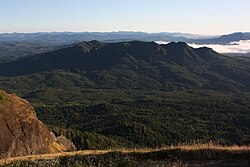Northern Oregon Coast Range
| Northern Oregon Coast Range | |
|---|---|

The Northern Coast Range, seen from Saddle Mountain in Clatsop County
|
|
| Highest point | |
| Peak | Rogers Peak |
| Elevation | 3,706 ft (1,130 m) |
| Coordinates | 45°39′53″N 123°32′53″W / 45.66472°N 123.54806°WCoordinates: 45°39′53″N 123°32′53″W / 45.66472°N 123.54806°W |
| Dimensions | |
| Length | 100 mi (160 km) north–south |
| Geography | |
| Country | United States |
| State | Oregon |
| Parent range | Oregon Coast Range |
| Borders on | Central Oregon Coast Range |
| Geology | |
| Orogeny | Geologic fault |
| Age of rock | Paleocene and Eocene |
| Type of rock | volcanic and forearc basin |
The Northern Oregon Coast Range is the northern section of the Oregon Coast Range, in the Pacific Coast Ranges physiographic region, located in the northwest portion of the state of Oregon, United States. This section of the mountain range, part of the Pacific Coast Ranges, contains peaks as high as 3,710 feet (1,131 m) for Rogers Peak. Forests in these mountains are considered to be some of the most productive timber land in the world. The Central Oregon Coast Range is directly south of this section with the Southern Oregon Coast Range beyond the central range.
The origins of these mountains began approximately 40 million years ago during the Eocene age. During this time-period, sandstone and siltstone formed in the area. Additionally, igneous rocks and basalt flows combined with basaltic sandstone to create many of the mountainous formations. Other sedimentary rock in the area formed more recently, around 20 million years ago. It is hypothesized that portions of the northern section of the range were islands during parts of the Eocene era. Other portions of the mountains consist of marine sedimentary rock. The entire coast range sits on a convergent tectonic margin interacting with the Juan de Fuca Plate that is subducting beneath North America tectonic plate. Also, weathering and erosion of the region is a major factor in shaping the landscape. Heavy rainfall and landslides have worked to alter the mountains.
The range is part of a broad, plunging structural arch of sedimentary and Tertiary volcanic strata that is being uplifted. Eocene and Miocene sections form the flanks of the uplifted sections. Some of the oldest rocks are submarine tholeiitic basalts from the Eocene era. The basalt came from the basalt flows that covered much of Oregon and originated from volcanoes in the central portion of the state. Other rocks include sandstone, mudstone, and siltstone. It was during the middle Miocene period that the range was uplifted in the broad, northeast-plunging arch.
...
Wikipedia
